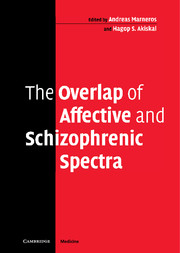Book contents
- Frontmatter
- Contents
- List of contributors
- Preface
- 1 The paradigma of overlapping affective and schizophrenic spectra: schizoaffective conditions
- 2 The overlapping of the spectra: overlapping genes and genetic models
- 3 The continuum of psychosis and its genetic basis
- 4 Functional psychoses: molecular-genetic evidence for a continuum
- 5 State- and trait-related deficits in sustained attention in bipolar disorder: are there any overlaps with schizophrenia?
- 6 The concept of schizoaffective disorder: utility versus validity and reliability – a transcultural perspective
- 7 Phenomenological approaches to the schizoaffective spectrum
- 8 Clinical course of schizoaffective disorders
- 9 Depressive syndromes in schizophrenia
- 10 The overlapping of the spectra: brief and acute psychoses
- 11 Overlapping of the spectra: physical comorbidity between schizophrenia and affective disorders
- 12 The overlapping of the spectra suicide
- 13 Biological treatment of schizoaffective disorders
- 14 Psychological therapies and schizoaffective disorders
- Epilogue: The interface of affective and schizophrenic disorders: a cross between two spectra?
- Index
2 - The overlapping of the spectra: overlapping genes and genetic models
Published online by Cambridge University Press: 02 September 2009
- Frontmatter
- Contents
- List of contributors
- Preface
- 1 The paradigma of overlapping affective and schizophrenic spectra: schizoaffective conditions
- 2 The overlapping of the spectra: overlapping genes and genetic models
- 3 The continuum of psychosis and its genetic basis
- 4 Functional psychoses: molecular-genetic evidence for a continuum
- 5 State- and trait-related deficits in sustained attention in bipolar disorder: are there any overlaps with schizophrenia?
- 6 The concept of schizoaffective disorder: utility versus validity and reliability – a transcultural perspective
- 7 Phenomenological approaches to the schizoaffective spectrum
- 8 Clinical course of schizoaffective disorders
- 9 Depressive syndromes in schizophrenia
- 10 The overlapping of the spectra: brief and acute psychoses
- 11 Overlapping of the spectra: physical comorbidity between schizophrenia and affective disorders
- 12 The overlapping of the spectra suicide
- 13 Biological treatment of schizoaffective disorders
- 14 Psychological therapies and schizoaffective disorders
- Epilogue: The interface of affective and schizophrenic disorders: a cross between two spectra?
- Index
Summary
Introduction
The overlapping spectra of clinical presentation in bipolar disorder and schizophrenia described elsewhere in this volume suggest overlapping etiology and a spectrum of pathophysiological mechanisms. Genetic studies provide a powerful route to dissecting such pathophysiological mechanisms and elucidating the etiological relationship between these syndromes. Many genetic traits display phenotypes with a similar spectrum presentation, better described as a quantitative genetic trait than a Mendelian one. Yet both bipolar disorder and schizophrenia have characteristics of both quantitative and dichotomous genetic traits, as does the relationship between the disorders. Various studies of families and twins have been conducted in order to understand the genetic relationships between these psychotic illnesses and the most appropriate genetic model. More recently, these questions have been informed by molecular genetic methods to identify the specific susceptibility genes. Together these data suggest that the complexity of the overlapping phenotype is a reflection of complex genetic underpinnings. In this chapter, these possible models and family studies will be reviewed, as well as the more recent molecular genetic studies. Possible models and genetic mechanisms responsible for these spectra will be discussed.
Genetic models
Single major locus models
The genetic models to be considered fall into two major categories. In the Mendelian or major locus model, one gene of large effect is primarily responsible for the genetic susceptibility to illness in each affected individual.
Information
- Type
- Chapter
- Information
- The Overlap of Affective and Schizophrenic Spectra , pp. 25 - 42Publisher: Cambridge University PressPrint publication year: 2006
